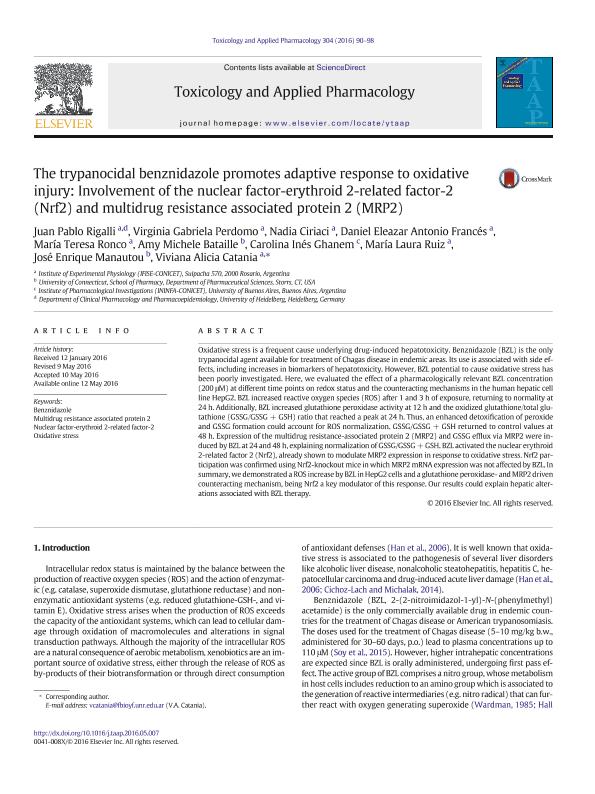Artículo
The trypanocidal benznidazole promotes adaptive response to oxidative injury: Involvement of the nuclear factor-erythroid 2-related factor-2 (Nrf2) and multidrug resistance associated protein 2 (MRP2)
Rigalli, Juan Pablo ; Perdomo, Virginia
; Perdomo, Virginia ; Ciriaci, Nadia
; Ciriaci, Nadia ; Frances, Daniel Eleazar Antonio
; Frances, Daniel Eleazar Antonio ; Ronco, Maria Teresa
; Ronco, Maria Teresa ; Bataille, Amy Michele; Ghanem, Carolina Inés
; Bataille, Amy Michele; Ghanem, Carolina Inés ; Ruiz, Maria Laura
; Ruiz, Maria Laura ; Manautou, José Enrique; Catania, Viviana Alicia
; Manautou, José Enrique; Catania, Viviana Alicia
 ; Perdomo, Virginia
; Perdomo, Virginia ; Ciriaci, Nadia
; Ciriaci, Nadia ; Frances, Daniel Eleazar Antonio
; Frances, Daniel Eleazar Antonio ; Ronco, Maria Teresa
; Ronco, Maria Teresa ; Bataille, Amy Michele; Ghanem, Carolina Inés
; Bataille, Amy Michele; Ghanem, Carolina Inés ; Ruiz, Maria Laura
; Ruiz, Maria Laura ; Manautou, José Enrique; Catania, Viviana Alicia
; Manautou, José Enrique; Catania, Viviana Alicia
Fecha de publicación:
08/2016
Editorial:
Academic Press Inc Elsevier Science
Revista:
Toxicology and Applied Pharmacology
ISSN:
0041-008X
Idioma:
Inglés
Tipo de recurso:
Artículo publicado
Clasificación temática:
Resumen
Oxidative stress is a frequent cause underlying drug-induced hepatotoxicity. Benznidazole (BZL) is the only antitripanocide agent available for treatment of Chagas disease in endemic areas. Its use is associated with side effects, including increases in biomarkers of hepatotoxicity. However, BZL potential to cause oxidative stress has been poorly investigated. Here, we evaluated the effect of a pharmacologically relevant BZL concentration (200 μM) at different time points on redox status and the counteracting mechanisms in the human hepatic cell line HepG2. BZL increased reactive oxygen species (ROS) after 1 and 3 h of exposure, returning to normality at 24 h. Additionally, BZL increased glutathione peroxidase activity at 12 h and the oxidized glutathione/total glutathione (GSSG/GSSG + GSH) ratio that reached a peak at 24 h. Thus, an enhanced detoxification of peroxide and GSSG formation could account for ROS normalization. GSSG/GSSG + GSH returned to control values at 48 h. Expression of the multidrug resistance-associated protein 2 (MRP2) and GSSG efflux via MRP2 were induced by BZL at 24 and 48 h, explaining normalization of GSSG/GSSG + GSH. BZL activated the nuclear erythroid 2-related factor 2 (Nrf2), already shown to modulate MRP2 expression in response to oxidative stress. Nrf2 participation was confirmed using Nrf2-knockout mice in which MRP2 mRNA expression was not affected by BZL. In summary, we demonstrated a ROS increase by BZL in HepG2 cells and a glutathione peroxidase- and MRP2 driven counteracting mechanism, being Nrf2 a key modulator of this response. Our results could explain hepatic alterations associated with BZL therapy.
Archivos asociados
Licencia
Identificadores
Colecciones
Articulos(IBR)
Articulos de INST.DE BIOLOGIA MOLECULAR Y CELULAR DE ROSARIO
Articulos de INST.DE BIOLOGIA MOLECULAR Y CELULAR DE ROSARIO
Articulos(IFISE)
Articulos de INST.DE FISIOLOGIA EXPERIMENTAL (I)
Articulos de INST.DE FISIOLOGIA EXPERIMENTAL (I)
Citación
Rigalli, Juan Pablo; Perdomo, Virginia; Ciriaci, Nadia; Frances, Daniel Eleazar Antonio; Ronco, Maria Teresa; et al.; The trypanocidal benznidazole promotes adaptive response to oxidative
injury: Involvement of the nuclear factor-erythroid 2-related factor-2
(Nrf2) and multidrug resistance associated protein 2 (MRP2); Academic Press Inc Elsevier Science; Toxicology and Applied Pharmacology; 304; 8-2016; 90-98
Compartir
Altmétricas



